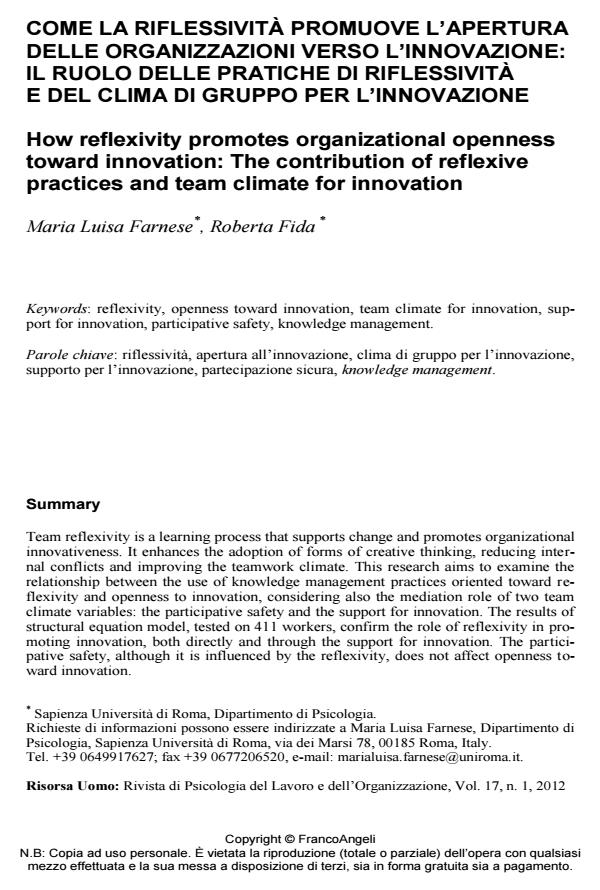How reflexivity promotes organizational openness toward innovation: The contribution of reflexive practices and team climate for innovation
Journal title RISORSA UOMO
Author/s Maria Luisa Farnese, Roberta Fida
Publishing Year 2014 Issue 2012/1
Language Italian Pages 16 P. 87-102 File size 897 KB
DOI 10.3280/RU2012-001009
DOI is like a bar code for intellectual property: to have more infomation
click here
Below, you can see the article first page
If you want to buy this article in PDF format, you can do it, following the instructions to buy download credits

FrancoAngeli is member of Publishers International Linking Association, Inc (PILA), a not-for-profit association which run the CrossRef service enabling links to and from online scholarly content.
Team reflexivity is a learning process that supports change and promotes organizational innovativeness. It enhances the adoption of forms of creative thinking, reducing internal conflicts and improving the teamwork climate. This research aims to examine the relationship between the use of knowledge management practices oriented toward reflexivity and openness to innovation, considering also the mediation role of two team climate variables: the participative safety and the support for innovation. The results of structural equation model, tested on 411 workers, confirm the role of reflexivity in promoting innovation, both directly and through the support for innovation. The participative safety, although it is influenced by the reflexivity, does not affect openness toward innovation.
La riflessività è un processo di apprendimento che sostiene il cambiamento nelle organizzazioni, promuovendone la capacità innovativa. Potenzia inoltre l’adozione di forme di pensiero creativo, riducendo la conflittualità interna e migliorando il clima di gruppo. Obiettivo della ricerca è analizzare la relazione tra l’utilizzo di pratiche di knowledge management orientate alla riflessività e l’apertura all’innovazione, considerando anche il ruolo di mediazione in questa relazione di due variabili di clima di gruppo: la partecipazione sicura e il supporto per l’innovazione. I risultati del modello di equazioni strutturali, testato su 411 lavoratori, confermano il ruolo della riflessività nel promuovere l’innovazione sia direttamente sia attraverso il clima di supporto per l’innovazione. La partecipazione sicura, sebbene sia influenzata dalla riflessività, non agisce sull’apertura all’innovazione.
Keywords: Reflexivity, openness toward innovation, team climate for innovation, support for innovation, participative safety, knowledge management.
- Methods to Measure the Extent to which Teachers’ Points of View Influence Creativity and Factors of Creative Personality: A Study with Italian Pupils Maria Elvira De Caroli, Orazio Licciardello, Elisabetta Sagone, Claudia Castiglione, in Key Engineering Materials /2010 pp.535
DOI: 10.4028/www.scientific.net/KEM.437.535
Maria Luisa Farnese, Roberta Fida, Come la riflessività promuove l’apertura delle organizzazioni verso l’innovazione: il ruolo delle pratiche di riflessività e del clima di gruppo per l’innovazione in "RISORSA UOMO " 1/2012, pp 87-102, DOI: 10.3280/RU2012-001009